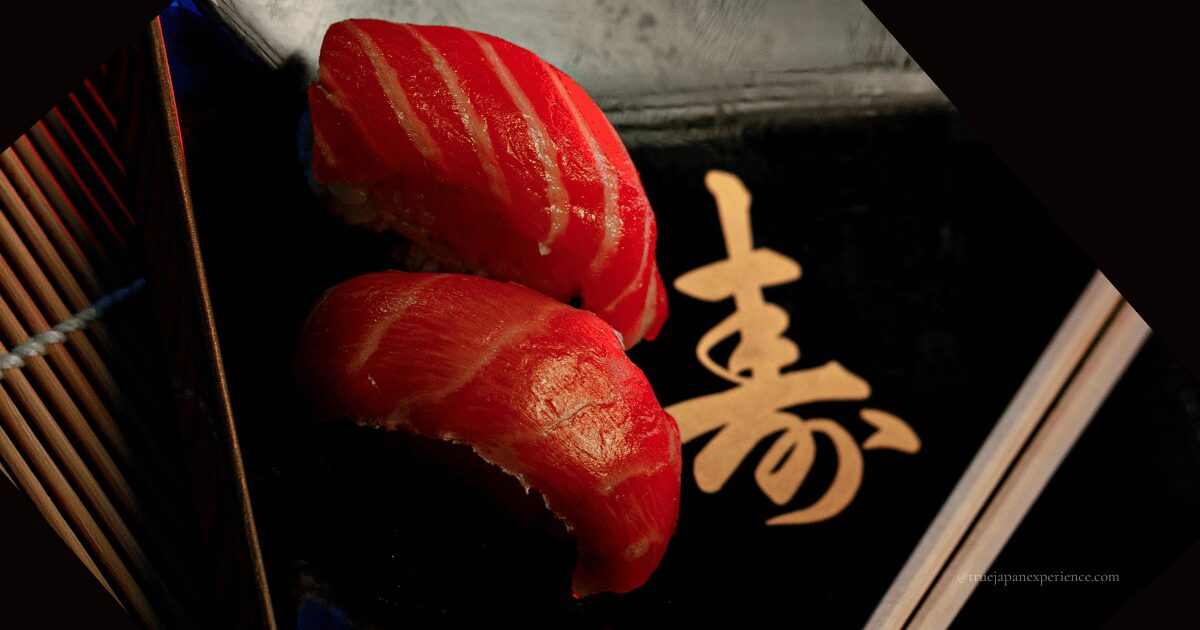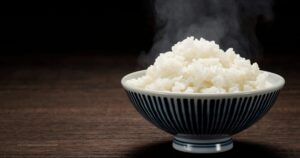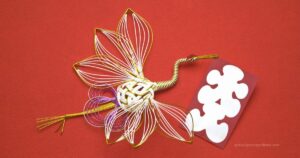Japanese sushi culture is famous around the world, but there’s more to it than just raw fish on rice.
From its long history to many regional styles and eating manners, sushi shows the heart of Japanese food tradition.
In this guide, you’ll learn what sushi really is, how it began, the different types in Japan, how to eat it politely, and how sushi looks in other countries.
Whether you’re a sushi beginner or a big fan, this is your simple and friendly guide to understanding sushi in Japan.
What Is Japanese Sushi? Japan’s Most Iconic Rice Dish
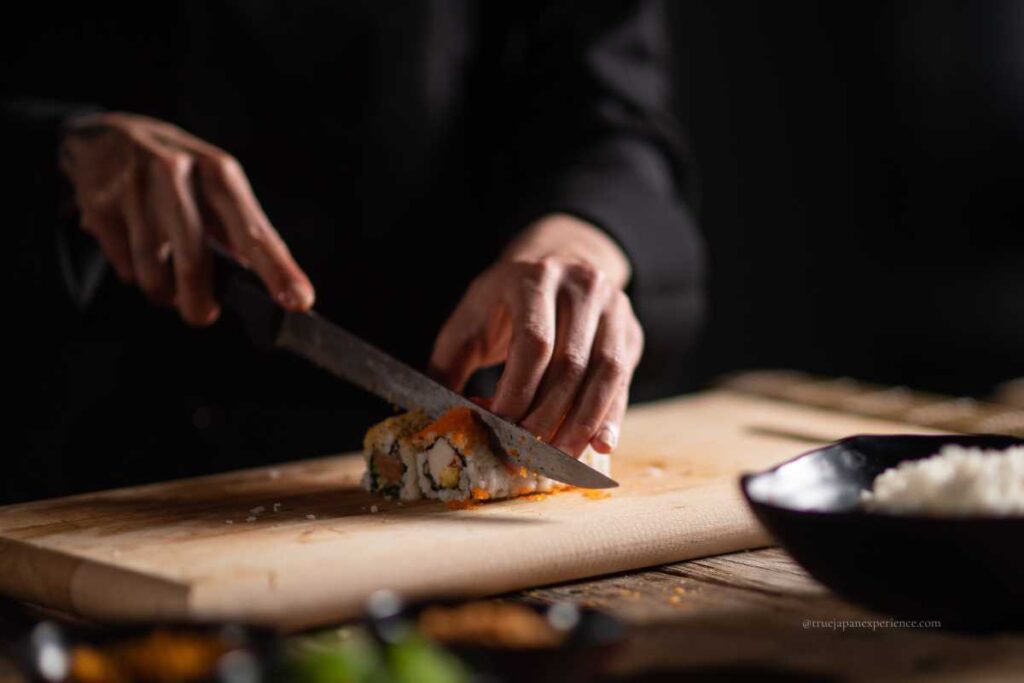
Sushi is a traditional Japanese food made with vinegared rice and different toppings or fillings. Most often, it includes seafood, but it can also use vegetables, eggs, or other ingredients.
Sushi has a long history.
Sushi began as narezushi, a way to keep fish fresh by using fermentation. This method came from Southeast Asia long ago.
In Japan, narezushi changed over time. People stopped fermenting the fish and started using vinegar to season the rice instead.
This new style of sushi is called hayazushi, and it became popular during the Edo period.
The most famous type today is nigiri-zushi. This is a small ball of rice with a slice of fresh fish on top. It is the kind of sushi you see in many restaurants in Japan and around the world.
There are many other styles too—like inari-zushi with sweet tofu skin, or even soba sushi made with noodles instead of rice.
Different Types of Japanese Sushi You Should Know
Today, sushi is enjoyed both in Japan and overseas.
It is not just a dish, but also a symbol of Japanese culture, with deep traditions and customs.
Sushi is more than just raw fish on rice—it’s a colorful, creative, and deeply local part of Japanese food culture.
While nigiri-zushi may be the most famous style, sushi in Japan comes in many forms.
From pressed sushi in Osaka to fermented styles in the countryside, each region has its own twist on this iconic dish.
In Japan, there are many different styles of sushi, each with its own shape, ingredients, and history.
Here are some popular and unique types you might see across the country.
Nigiri-zushi: The Classic Style
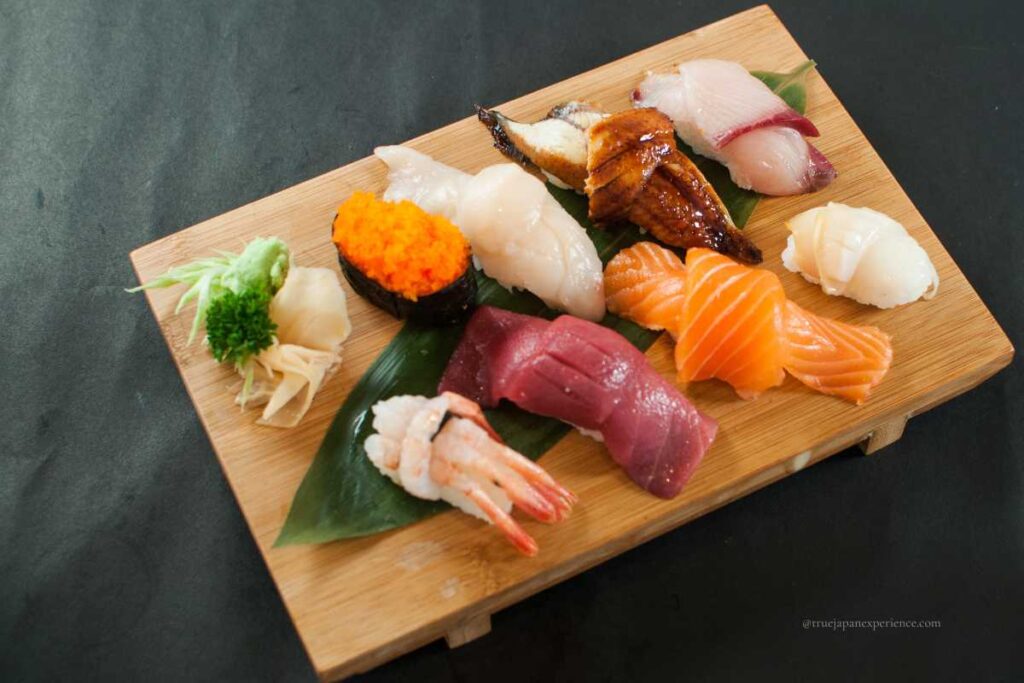
Nigiri-zushi started in Edo (now Tokyo) during the late Edo period.
It’s made by shaping vinegared rice into a small oval, then placing seafood or egg on top. This style is now the most well-known sushi in Japan and around the world.
Long ago, there were no refrigerators. So people used vinegar, salt, or heat to keep the fish fresh.
This “extra step” gave nigiri-zushi its special flavor.
At first, nigiri was two to three times bigger than today. It was made for busy Edo townspeople who wanted a fast, filling street food.
Today, nigiri has many styles.
Oshi-zushi: Pressed Sushi from Western Japan
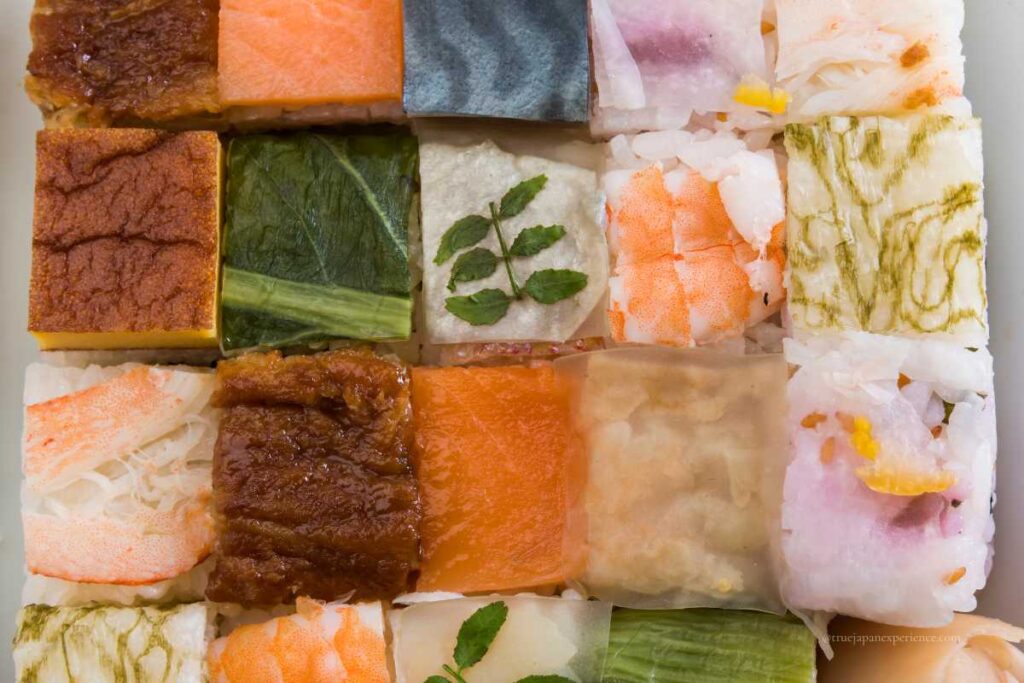
Oshi-zushi is made by pressing vinegared rice and toppings into a wooden mold.
This type of sushi is common in western Japan, especially in Osaka, Kyoto, and Nara.
Here are some famous types:
Battera: A pressed mackerel sushi from Osaka. Sometimes kombu (kelp) is placed on top.
Hako-zushi: A layered sushi with shrimp, sea bream, egg, and more. Very pretty and elegant.
Kaki-no-ha-zushi: Sushi wrapped in persimmon leaves from Nara and Wakayama.
Masu-zushi: A round sushi made with trout from Toyama. Often sold as a train station bento.
Bo-zushi: A long, stick-shaped pressed sushi. Kyoto’s saba (mackerel) bo-zushi is popular.
Oshi-zushi is colorful, beautiful, and easy to carry, so people often eat it for celebrations or trips.
Chirashi-zushi: Scattered and Colorful
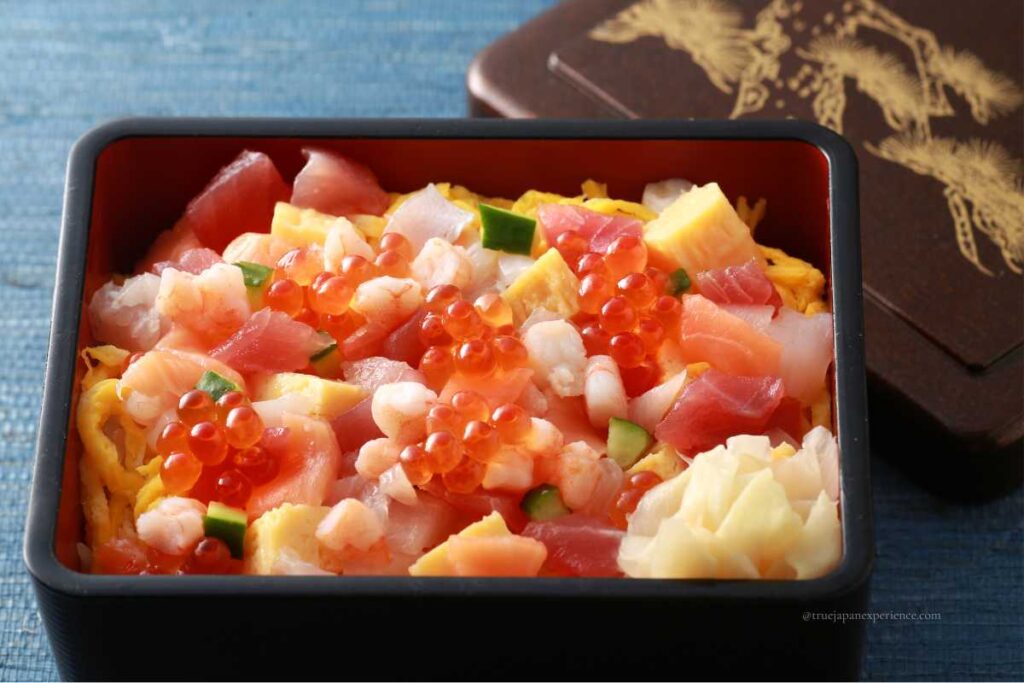
Chirashi-zushi means “scattered sushi.” It’s made by placing colorful toppings over vinegared rice, or by mixing ingredients into the rice.
The origin is not clear, but one story says it came from a law in the Edo period.
People weren’t allowed to eat rich meals, so they hid fish and vegetables inside rice. Later, this idea became a fun and festive dish.
Today, chirashi-zushi is common for special days like Hinamatsuri (Girls’ Day). Its bright look and mix of flavors make it a favorite for family celebrations.
Inari-zushi: Sweet and Simple
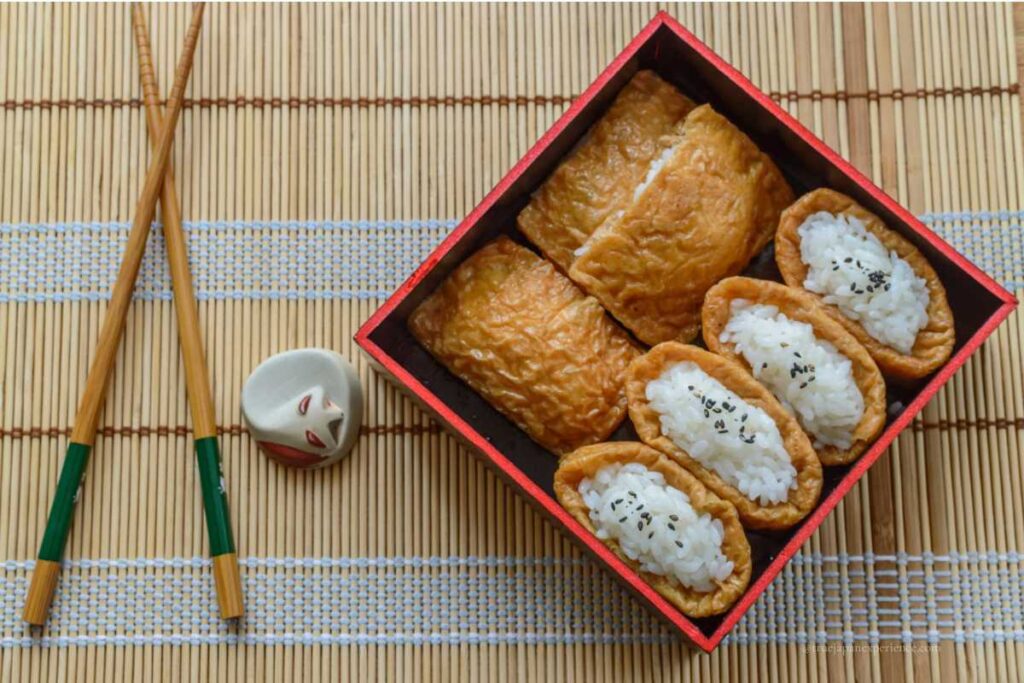
Inari-zushi is sushi rice stuffed into sweet tofu skin pouches.
The tofu skin, called abura-age, is made by deep-frying thin slices of tofu. It is then cooked in a sweet and salty sauce.
Some people mix the rice with sesame seeds, carrots, or mushrooms before filling.
The shape is different by region.
In eastern Japan, it’s usually rectangular. In western Japan, it’s often triangle-shaped.
One story says that Inari-zushi got its name from Inari, a Shinto god of farming and business.
In Japanese belief, foxes are the messengers of Inari. People say foxes love deep-fried tofu, so rice wrapped in sweet tofu skin became a special offering at Inari shrines.
That’s why Inari-zushi is often eaten during festivals and used as an offering.
You can learn more about Inari and visit the famous fox shrine in Kyoto here: Fushimi Inari Taisha – Kyoto’s Shrine of Foxes and Torii Gates.
Now, it’s a common food sold in supermarkets, bento shops, and at picnics.
Maki-zushi: Rolled Sushi with Many Flavors
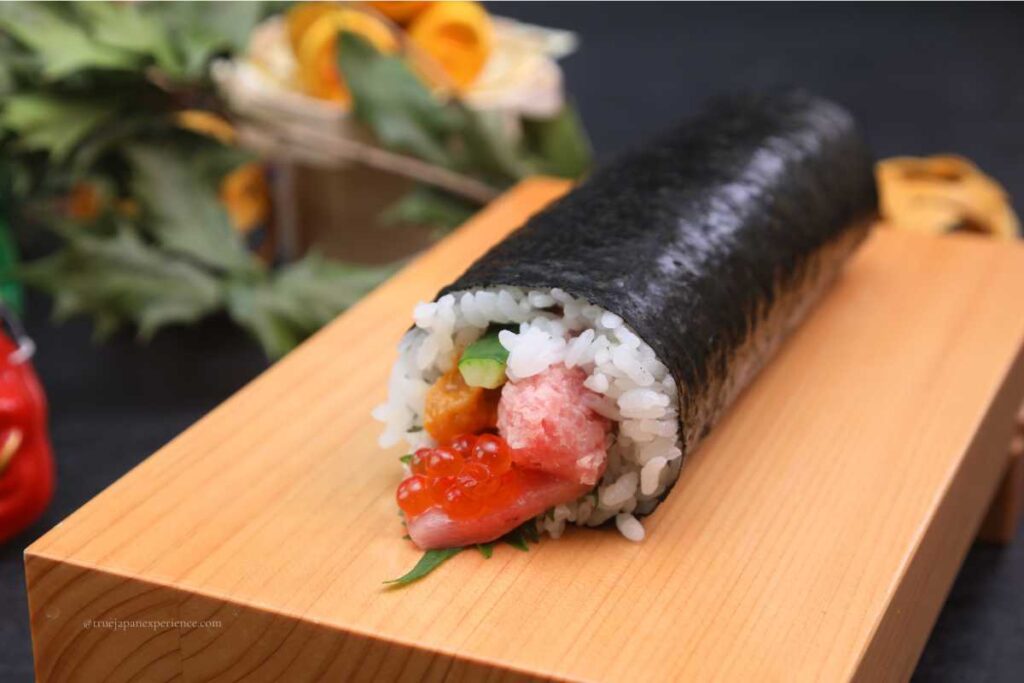
Maki-zushi is a type of sushi made by rolling vinegared rice and fillings with seaweed or thin egg sheets. The roll is then cut into bite-sized pieces. It’s a colorful and fun way to enjoy sushi in Japan.
Maki-zushi began in the mid-1700s during the Edo period.
At first, people used things like egg, seaweed, or bamboo skin to wrap the sushi. Later, seaweed farming and sheet-style nori became popular in Edo (now Tokyo), and the seaweed roll became the standard.
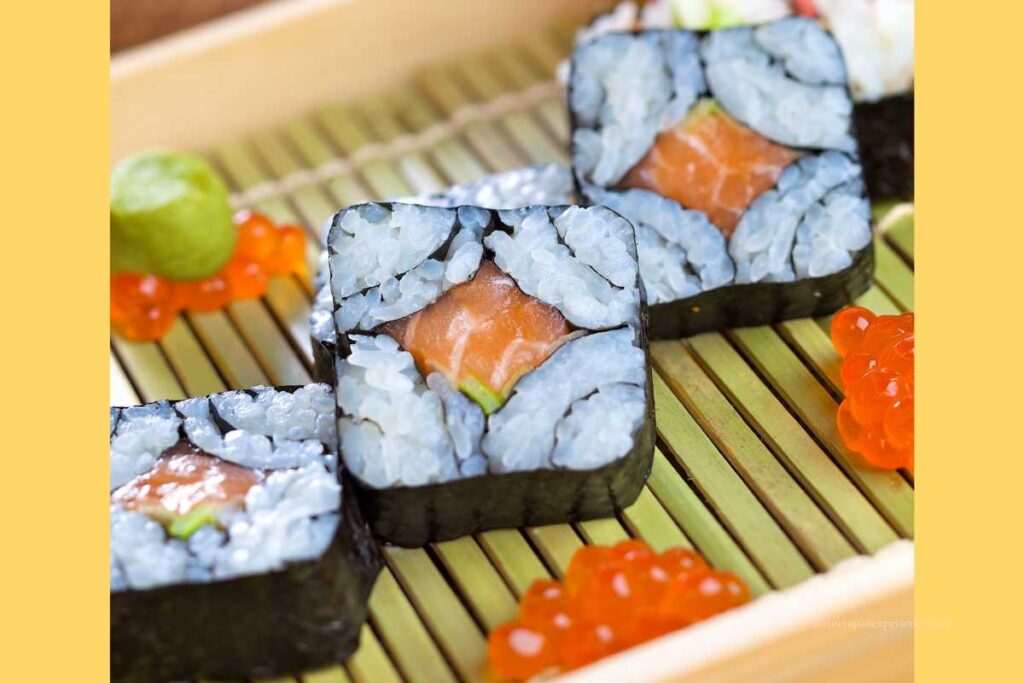
This style of sushi became a special dish at home, especially for parties and happy occasions. Even today, many families make maki-zushi for festivals or celebrations.
Maki-zushi can have many fillings—like cooked gourd (kanpyō), sweet egg (tamago), cucumber, mushrooms, eel, or pink fish flakes (denbu).
In eastern Japan (like Tokyo), people prefer thin rolls with one filling. In western Japan (like Osaka), people enjoy thick rolls with many colorful fillings.
There is even a special kind called decorative maki-zushi, where the cut pieces look like flowers or patterns!
Sushi in Japan: Conveyor Belt vs. Sushi Bar Experience
In Japan, there are two main ways to enjoy sushi: kaiten-zushi (conveyor belt sushi) and sushi bars with a chef at the counter.
Both offer tasty sushi, but the experience is very different.
Let’s see what makes each one special—and which style is right for you.
Kaiten-zushi: Fun, Easy, and Great for First-Timers
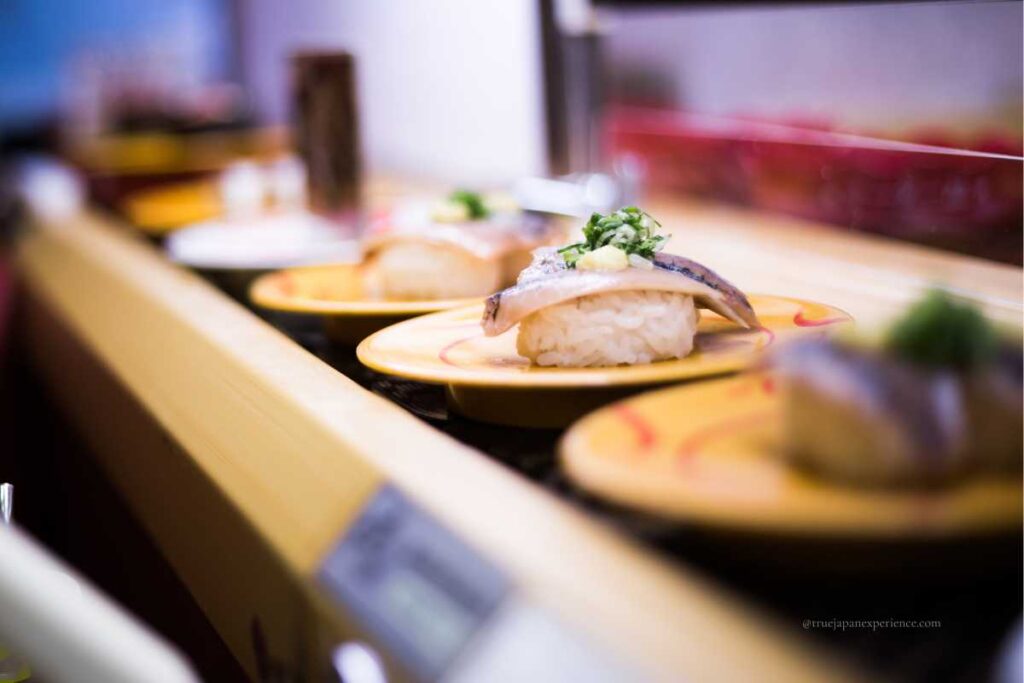
Kaiten-zushi restaurants are casual, quick, and very popular across Japan.
Plates of sushi ride a moving belt through the shop, and you simply take the ones that catch your eye. You can also place special orders using a touchscreen, and fresh sushi will come straight to your seat.
Prices are usually very affordable—many plates cost between ¥100 and ¥300. You’ll find classic sushi like tuna or shrimp, but also creative rolls with mayonnaise, fried foods, or even desserts.
It’s a great way to try many different styles in one visit, without pressure.
・Easy for first-time sushi eaters and families
・Affordable and casual
・Many choices, from traditional to modern styles
・Self-service tea, wasabi, soy sauce, and pickled ginger
Kaiten-zushi is a fun, no-stress way to enjoy Japanese sushi, especially if you’re just getting started.
Japanese Sushi Bars: Traditional Dining with the Chef
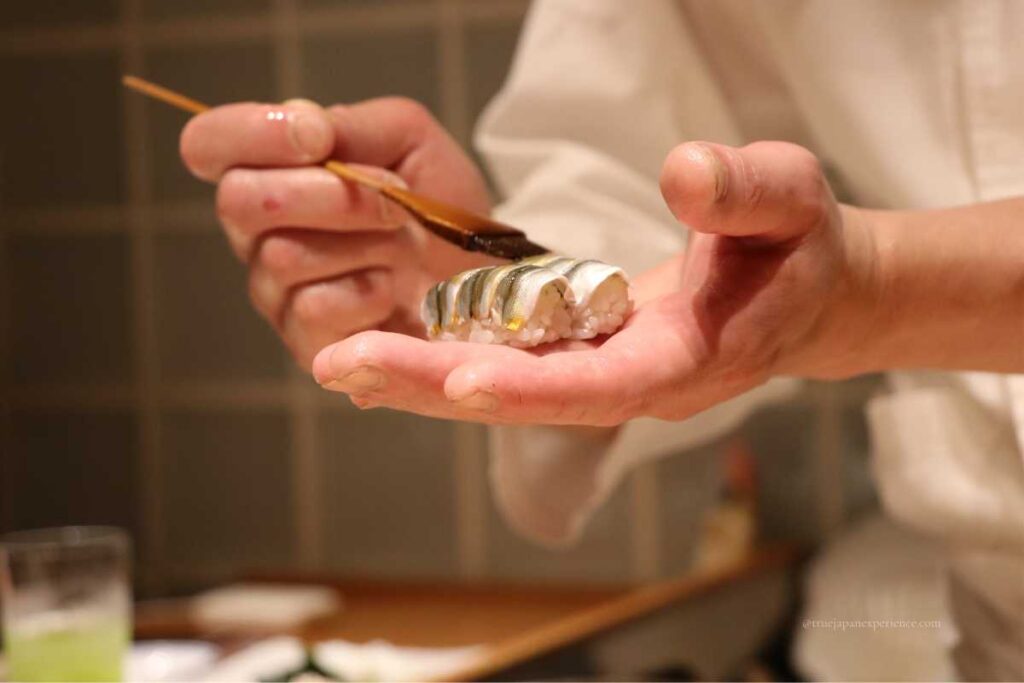
Sitting at a sushi counter is a very different experience.
Here, a skilled sushi chef prepares each piece right in front of you—one at a time, by hand. This style is known for its care, tradition, and quiet atmosphere.
You can also choose “omakase”, where the chef selects a series of seasonal sushi pieces for you.
If you already have some favorites, you can request them as well. Talking with the chef about the fish, rice, or technique is part of the experience.
It’s more than just a meal—it’s a chance to connect with Japanese culture on a deeper level.
・Watch sushi made right before your eyes
・Experience seasonal and local fish at its best
・Enjoy a slower, more mindful pace
While sushi bars are more expensive, they offer a deeper, more personal sushi experience that many travelers remember for a lifetime.
Which One Should You Try?
There’s no right answer.
If you want something fast and fun, kaiten-zushi is perfect. If you want to learn more about sushi and enjoy each piece slowly, try a sushi bar.
Sushi isn’t just something you eat — it’s something you can create!
Why not try making your own sushi in Japan with the help of a professional chef?
It’s a fun, hands-on experience that gives you a whole new appreciation for this iconic Japanese dish.
How to Eat Japanese Sushi
Sushi is simple and delicious, but there are some small manners that help you enjoy it in the right way—especially at a sushi bar where the chef makes each piece in front of you.
You don’t need to be perfect. But with a few easy tips, you can enjoy Japanese sushi more like a local!
Japanese Sushi Etiquette: Easy Tips and Good Manners
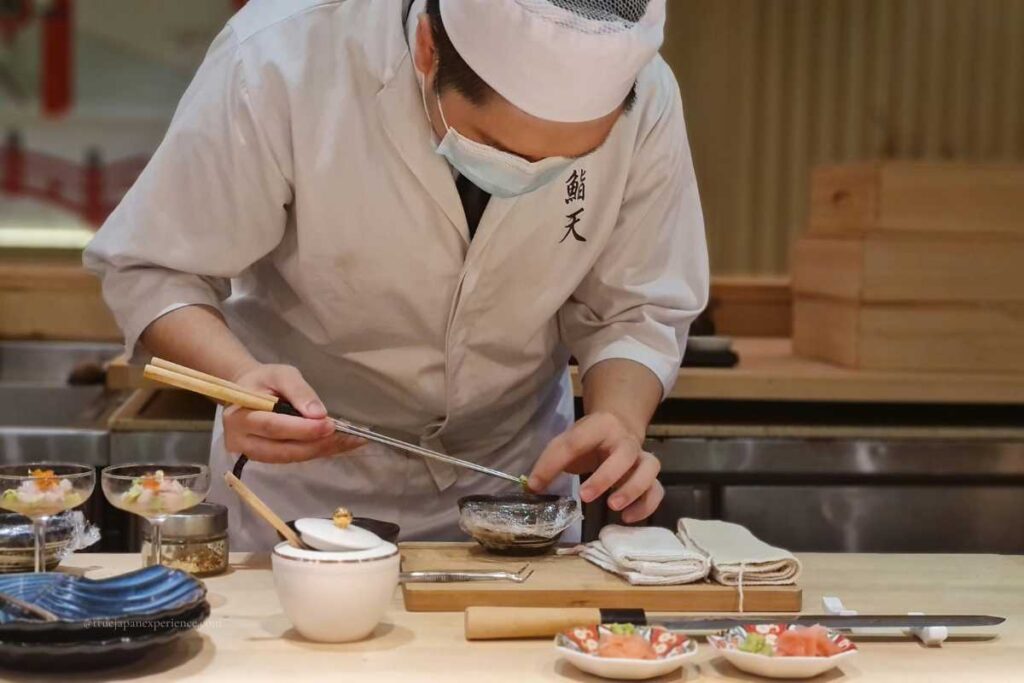
Now, let’s look at some useful tips and manners for eating at a high-end sushi bar, where the chef makes each piece of sushi right in front of you.
◆ Use hands or chopsticks—both are okay
In the past, Edo-style sushi was sold at street stalls, and it was made to be picked up easily by hand. That’s why many people still see eating sushi with your hands as the traditional and stylish way.
Back then, using your fingers was normal. Even today, it’s perfectly okay to eat sushi with your hands—especially at sushi bars where the chef serves it piece by piece.
However, using chopsticks is also completely fine, and many people choose that. Just remember: if you use your hands, it’s polite to clean your fingers with a wet towel (oshibori) before eating.
Also, pickled ginger (gari) should always be eaten with chopsticks.
◆ How to use soy sauce
When using soy sauce with sushi, the key is to dip only the side of the fish, not the rice.
Rice soaks up too much soy sauce and may fall apart. It also changes the taste too much and hides the natural flavor of the fish.
To do it right, hold the sushi gently with your hand or chopsticks. Then, turn it slightly and dip just the edge of the fish into the soy sauce. You don’t need a lot—a little is enough.
For soft sushi like gunkan-maki (with sea urchin or salmon roe), don’t dip it directly. Instead, use a piece of pickled ginger or cucumber. Dip that in the soy sauce and gently brush it on top of the sushi.
Also, don’t fill your soy sauce dish too much. Just pour a small amount and add more if needed.
◆ Eat it in one bite
Sushi is made with care—the chef balances the rice and the topping just right. That’s why it’s best to eat each piece in one bite.
If you bite it in half, the shape may break, and you won’t enjoy the full flavor. Also, it’s not polite to take a bite and put the rest back on your plate.
Of course, some pieces like gunkan-maki may be too big for one bite. In that case, hold it in your hand and eat it gently in two bites without putting it down.
Here’s a small tip to enjoy nigiri even more:
Turn the sushi a little sideways and place it in your mouth with the topping facing down.
This way, the fish touches your tongue first, and you can enjoy the full flavor more clearly.
It helps you taste the delicate texture and natural umami of the topping.
Good balance, gentle handling, and the right angle—all make sushi even more delicious.
◆Eat It Fresh – Don’t Wait Too Long
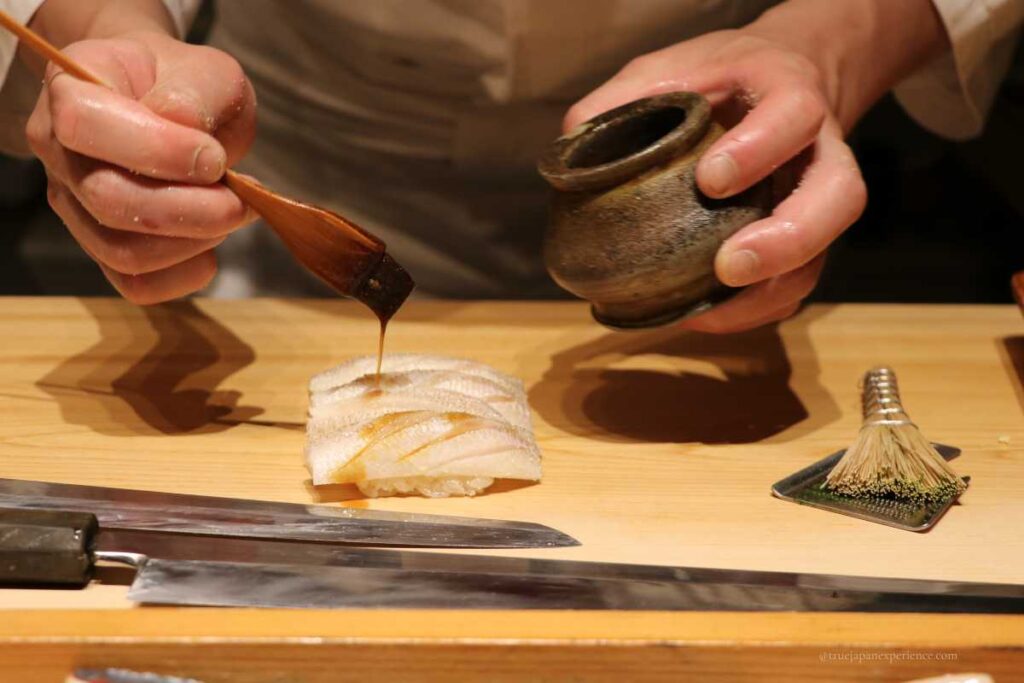
Sushi tastes best right after the chef makes it.
Each piece is carefully made with perfect timing—rice at just the right temperature, fresh toppings, and the perfect texture.
If you wait too long, the rice gets cold and hard. The fish may lose its freshness and become dry.
This means you miss the best moment to enjoy the sushi.
At high-end sushi bars, the chef gives you one piece at a time.
Eating it right away is a way to show respect. It’s like keeping rhythm with the chef—this timing is part of the experience.
So when the sushi is served, try not to leave it sitting on the plate.
Taking long photos or chatting too much before eating can spoil the taste.
Just enjoy it while it’s at its best.
Start with light flavors, end with rich ones
When eating Japanese sushi, the order can make a big difference in taste.
Many people start with white fish or squid, which have light and clean flavors. Then they move to stronger fish like tuna, mackerel, or bonito. At the end, they enjoy rich toppings like sea urchin or grilled eel.
This way, you can enjoy the full range of flavors without one sushi overpowering the next.
It also helps your mouth stay fresh and not feel too oily too fast.
But don’t worry—there are no strict rules. You can always eat your favorites first if you like.
Today, many Japanese people don’t know this order, and modern sushi places are more casual than before.
These manners are mainly for high-end sushi bars, where a chef makes each piece in front of you.
In these places, being polite and careful shows respect for the chef and other guests.
But at conveyor belt sushi (kaiten-zushi) or casual sushi shops, the mood is more relaxed.
Still, showing basic manners—like not playing with food or taking too long to eat—is always a good idea.
Why Is Ginger (Gari) Always Served with Sushi?
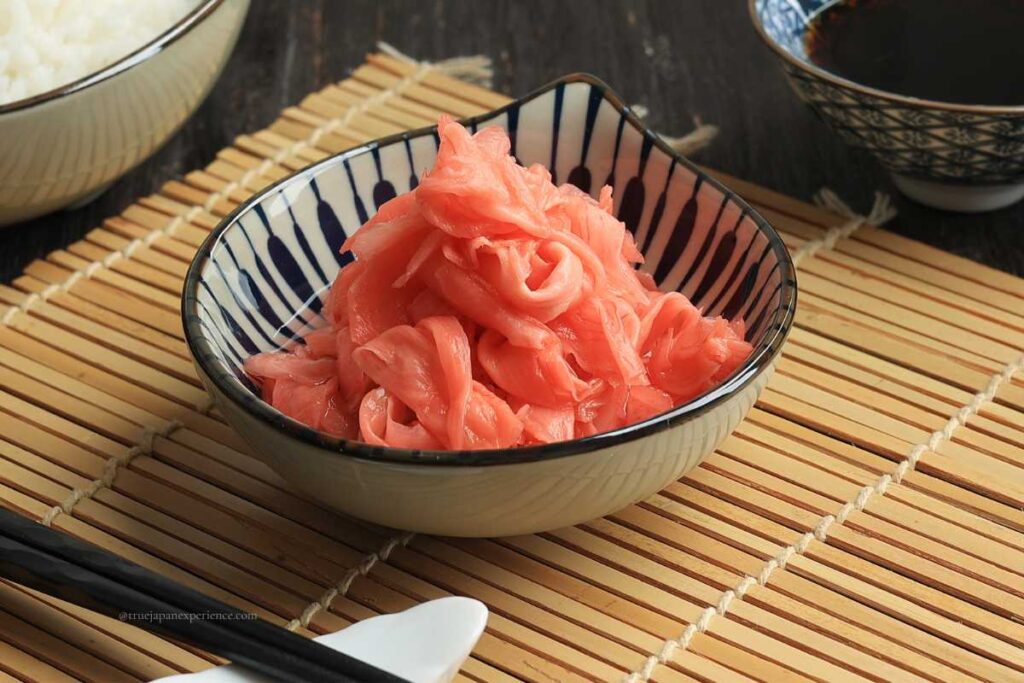
Gari is thinly sliced ginger pickled in sweet vinegar. It’s always found alongside sushi—not just for decoration, but with purpose.
The name “gari” is said to come from the crunchy sound made when cutting or chewing it.
This pickled ginger acts as a palate cleanser. Its mild spice and acidity help remove the taste of the last piece so you can enjoy the next one with a fresh mouth.
Gari also has antibacterial properties thanks to natural compounds like gingerol. This makes it a smart match with raw fish, supporting both flavor and food safety.
Some believe it helps digestion and even warms the body—making it a quiet, but powerful partner in the sushi experience.
In short, gari is more than a side dish—it’s there to help you enjoy sushi safely, comfortably, and deliciously.
Final Thoughts: Discover the Joy of Japanese Sushi Culture
Japanese sushi culture is rich, beautiful, and surprisingly easy to enjoy—even for first-timers.
Whether you grab a plate at a busy kaiten-zushi or sit quietly at a sushi bar, you’re tasting more than just fish and rice. You’re sharing in a tradition that has grown for centuries.
Don’t worry about being perfect.
With just a little care and curiosity, your sushi experience in Japan will be not only delicious—but unforgettable.
Want to learn more about Japanese food traditions?
👉 Beyond Sushi: Discover Japan’s Unique Rice Dishes and Healthy Brown Rice Culture
👉 Washoku: A Cultural and Culinary Journey Through Traditional Japanese Food
